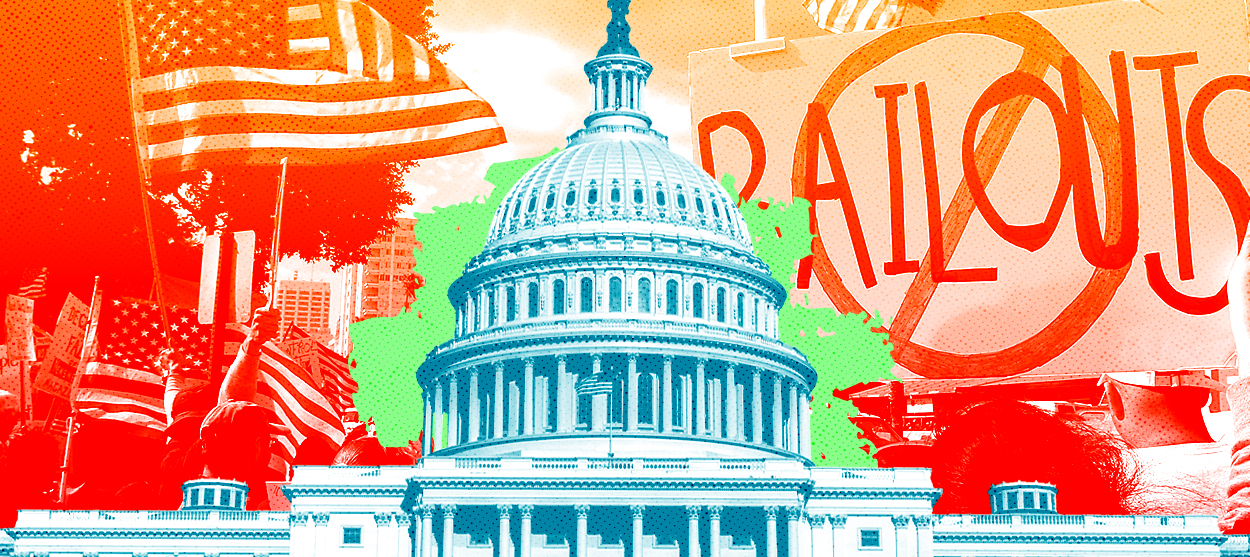The Tea Party case for the Trump stimulus
This is a different kind of economic crisis


How relevant can fiscal conservatism be in a genuinely acute national crisis? Stock markets are crashing, jobs are shutting down, and people have started to learn "social distancing" since the coronavirus pandemic hit the United States. State and local authorities have shuttered restaurants and bars, school closures have forced parents to stop working, and the economy is teetering as badly as it did in 2008, when the housing bubble burst and bad debt nearly destroyed the financial sector.
The economic crisis has its direct cause from government intervention, no matter how wise those mitigation actions are. Therefore, it is appropriate for government to intervene to limit the damage done at all levels as much as is rational and feasible, including and especially at the federal level. Fiscal conservatives, like the Tea Partiers of the Obama presidency, would consider that anathema in normal circumstances, but clearly these are not normal circumstances — and won't be for several weeks, if not months. In this case, however, the economic damage does not come from a structural failure of the economy itself, but necessarily dramatic government action that temporarily halts economic activity. That means the solution can be targeted at the damage done rather than structural issues within the U.S. economy.
The debate now over an economic stimulus, as it was in 2009, is not so much about scope or cost. All sides now agree that, as President Donald Trump said on Tuesday, that "we want to go big." Republicans who normally argue over budget deficits and increased federal spending are either backing a large stimulus program or at least not openly opposing it. Even Sen. Rand Paul (R-KY), the most hawkish of deficit hawks, skipped over arguing over the scope of the coming bailout to argue instead that Washington should cut spending in other areas to offset some of the anticipated costs.
The Week
Escape your echo chamber. Get the facts behind the news, plus analysis from multiple perspectives.

Sign up for The Week's Free Newsletters
From our morning news briefing to a weekly Good News Newsletter, get the best of The Week delivered directly to your inbox.
From our morning news briefing to a weekly Good News Newsletter, get the best of The Week delivered directly to your inbox.
"Next time, maybe in the not-too-distant future," Paul warned in a floor speech while offering an amendment to an earlier House stimulus effort, "our children may not even be able to borrow their way out of a crisis." In a measure of just how far fiscal-discipline concerns go these days, Paul's amendment to offset the costs by shifting other appropriations and declare an immediate end to the war in Afghanistan only got three votes in the Republican-majority Senate.
Still, while fiscal conservatism might not apply to the overall approach by Congress to the economic crisis, it should inform how to best use the funds it will spend to blunt it. That means targeting the money where the damage is most acutely felt rather than to commit it to longer-term programmatic goals. Subsidiarity is key to making the biggest impact, while trying to leverage the crisis for re-engineering the economy is the best way to ensure that the money and the opportunity get wasted.
In the 2009 stimulus bill, Democrats focused most of their efforts on restructuring, both literally and figuratively, and ended up providing an avalanche of pork for their favored interests. The bill poured hundreds of billions of dollars into supposedly "shovel ready" projects that mainly consisted of road-repair work that just accelerated their schedules. It added nothing to economic output, but instead just shifted it up slightly. The same was true for the smaller "Cash for Clunkers" program that attempted to take older, higher-emission vehicles off the road as part of the administration's environmental agenda. That program not only resulted in just goosing already-existing demand a quarter faster, it made used cars more expensive for poorer families who needed vehicles thanks to the required destruction of the trade-ins.
Other programs, such as the green-energy investments, paid off even more poorly. Those investment went to many companies struggling to justify interests from venture capital outfits, and their performance demonstrated why. The Obama administration sunk a half-billion dollars into Solyndra alone, which promptly collapsed, in addition to several other green-sector failures that added nothing to economic output. Those failures cost taxpayers billions of dollars for no return at all, not even an appreciable acceleration of renewable-energy output. (Tesla was one of the outliers, but it didn't need the cash — it didn't even ask for it.)
A free daily email with the biggest news stories of the day – and the best features from TheWeek.com
Even the funds that specifically targeted saving jobs turned into pork. The bill offered grants to states to salvage state and local government jobs, especially teachers and first responders, as states don't have the flexibility to use deficit spending to keep those jobs open in economic crises. Some want to use a similar stimulus for states now for the same reason. However, states mainly used that emergency money to patch over unrelated budget holes and avoid the necessary restructuring to protect those jobs long-term. President Obama tried to argue that the layoffs that took place when the money ran out two years later proved the success of the program, but what it actually showed was that the money had let state governments avoid necessary fiscal discipline while spending the money on other priorities.
At the same time, Republicans and fiscal conservatives focused on their hobby horses too much in 2009 as well. Their demands for tax cuts and regulatory relief might have made sense for normal economic policy, but were not well suited for an emergency response to an economic crisis. Long-term economic policy won't abate a short-term crisis, and spending tons of cash without abating the crisis is a waste of limited economic and fiscal power.
This rescue package should focus sharply on the points of the economy where government inflicted the most damage. The highest priority has to be consumers sidelined by business closures — putting enough money in their pockets to keep them engaged in the economy. Fortunately, both parties have more or less come around to direct payments over the next two months, which will cost around $500 billion but will keep families from tipping over into ruin. That added spending power will boost local businesses as well, keeping some dynamism in the economy while keeping families mostly at home.
Next, funds needs to target the most critical costs of keeping small businesses running through the crisis. Either that also means direct payments or perhaps grants and bridge loans to keep operating expenses under control and lease payments made. Former New Jersey governor Chris Christie proposed a wider repeat of the Hurricane Sandy recovery effort, which used HUD's Community Development Block Grant (CDBG) program to keep small- and medium-sized businesses from shutting down during that crisis. If funds get rapidly deployed into those programs, small businesses such as restaurants and bars can either avoid or limit employee furloughs, also allowing for more resiliency and dynamism in the immediate term and limiting long-term damage.
Both of these approaches have significant scalability, as well. If the effect is not robust enough at first, Congress can direct more funds to bolstering these programs. Refraining from launching expensive long-term programs aimed at political goals will provide even greater flexibility, and furthermore allow more clarity to ensure that these programs work as intended.
Larger industries have been damaged by this pandemic, including travel, tourism, and especially the airlines. But since these industries were bailed out by the federal government after 9/11, flat-out grants now might not fly with voters who see the affected corporations as robust enough to survive. They have demanded as much as $60 billion in direct grants for their own rescue, but the Trump administration's decision to structure that part in low-interest loans is likely wise. Part of any economic rescue has to deal with the psychology of the market, and consumers felt stung by the corporate bailouts in 2009-10 in the financial and auto sectors while seeing little or none of the resources reach them directly. Another round of Wall Street before Main Street will sap consumer confidence and make recovery even slower and more painful.
In the immediate crisis, going big is unavoidable. But in going big, Congress and the White House should also go home with the money — and put it where it will do the most immediate good. The rest of their agendas can wait for the election in November.
Want more essential commentary and analysis like this delivered straight to your inbox? Sign up for The Week's "Today's best articles" newsletter here.
Edward Morrissey has been writing about politics since 2003 in his blog, Captain's Quarters, and now writes for HotAir.com. His columns have appeared in the Washington Post, the New York Post, The New York Sun, the Washington Times, and other newspapers. Morrissey has a daily Internet talk show on politics and culture at Hot Air. Since 2004, Morrissey has had a weekend talk radio show in the Minneapolis/St. Paul area and often fills in as a guest on Salem Radio Network's nationally-syndicated shows. He lives in the Twin Cities area of Minnesota with his wife, son and daughter-in-law, and his two granddaughters. Morrissey's new book, GOING RED, will be published by Crown Forum on April 5, 2016.
-
 Has Zohran Mamdani shown the Democrats how to win again?
Has Zohran Mamdani shown the Democrats how to win again?Today’s Big Question New York City mayoral election touted as victory for left-wing populists but moderate centrist wins elsewhere present more complex path for Democratic Party
-
 Millions turn out for anti-Trump ‘No Kings’ rallies
Millions turn out for anti-Trump ‘No Kings’ ralliesSpeed Read An estimated 7 million people participated, 2 million more than at the first ‘No Kings’ protest in June
-
 Ghislaine Maxwell: angling for a Trump pardon
Ghislaine Maxwell: angling for a Trump pardonTalking Point Convicted sex trafficker's testimony could shed new light on president's links to Jeffrey Epstein
-
 The last words and final moments of 40 presidents
The last words and final moments of 40 presidentsThe Explainer Some are eloquent quotes worthy of the holders of the highest office in the nation, and others... aren't
-
 The JFK files: the truth at last?
The JFK files: the truth at last?In The Spotlight More than 64,000 previously classified documents relating the 1963 assassination of John F. Kennedy have been released by the Trump administration
-
 'Seriously, not literally': how should the world take Donald Trump?
'Seriously, not literally': how should the world take Donald Trump?Today's big question White House rhetoric and reality look likely to become increasingly blurred
-
 Will Trump's 'madman' strategy pay off?
Will Trump's 'madman' strategy pay off?Today's Big Question Incoming US president likes to seem unpredictable but, this time round, world leaders could be wise to his playbook
-
 Democrats vs. Republicans: who are US billionaires backing?
Democrats vs. Republicans: who are US billionaires backing?The Explainer Younger tech titans join 'boys' club throwing money and support' behind President Trump, while older plutocrats quietly rebuke new administration



